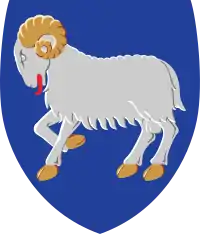 |
|---|
Partial general elections were held in the Faroe Islands in 1901 to elect nine of the eighteen elected members of the Løgting.[1] The Danish administrator (Amtmaður) and the local dean (Próstur) were also members, with the administrator serving as the speaker.[2]
Electoral system
Members of the Løgting were elected by first-past-the-post voting, with voters having as many votes as there were seats available in their constituency. Nine of the 18 seats were elected every two years. Voting was restricted to men aged 25 or over who met certain tax-paying criteria.[1]
Results
| Constituency | Elected members | Notes |
|---|---|---|
| Norðoyggjar | Jógvan Michael Matras | |
| Klæmint Olsen | Re-elected | |
| Sandoy | Johan Hendrik Schrøter | Previously elected in Suðuroy |
| Jóhan Hendrik Poulsen | Re-elected | |
| Suðuroy | Niels Juel Mortensen | |
| Jóannes Patursson | ||
| Suðurstreymoy | Jens Andreasen | |
| Djóni í Geil | ||
| Poul Niclasen | ||
| Source: Løgting[1] | ||
References
- 1 2 3 "LØGTINGIÐ 150" (PDF). Løgting.
- ↑ Hans Andrias Sølvará (2016). The Rise of Faroese Separatism: Danish-Faroese relations from 1906–1925 and the radicalization of the national- and home rule question. Faroe University Press.
This article is issued from Wikipedia. The text is licensed under Creative Commons - Attribution - Sharealike. Additional terms may apply for the media files.